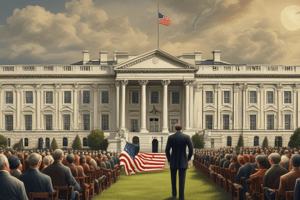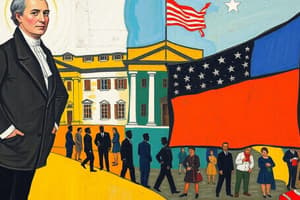Podcast
Questions and Answers
The U.S President is elected through a direct popular vote system.
The U.S President is elected through a direct popular vote system.
False (B)
After Mao Zedong's death in 1976, China transitioned to a multi-party political system.
After Mao Zedong's death in 1976, China transitioned to a multi-party political system.
False (B)
Xi Jinping has been serving as the General Secretary of the Communist Party of China since 2017.
Xi Jinping has been serving as the General Secretary of the Communist Party of China since 2017.
True (A)
Deng Xiaoping's Economic Reform and Opening Up Policy had no significant impact on China's economy and society.
Deng Xiaoping's Economic Reform and Opening Up Policy had no significant impact on China's economy and society.
The concept of separation and balance of powers exists between the executive and legislative branches in China's political system.
The concept of separation and balance of powers exists between the executive and legislative branches in China's political system.
Flashcards are hidden until you start studying
Study Notes
Presidential History
The role of president has been a significant one throughout human civilization, with different cultures having their own versions of leaders who represent the people. In this section, we will delve into the various aspects of presidential history across several civilizations.
Ancient Egypt
In ancient Egypt, the pharaoh was considered divine and held absolute power over all aspects of life. This system had its roots in religious beliefs, where the king's authority came from his status as a divinely appointed ruler. Pharaonic Egypt also saw the rise of powerful female rulers such as Hatshepsut and Cleopatra, demonstrating how even early societies recognized women could hold executive roles in government.
India
India's first democratic elections were conducted by the British colonial authorities under the Government of India Act 1935. By 1947, when independence was achieved, India became a quasi-federal parliamentary democracy with an elected president as head of state. The Indian Constitution provides for both a directive principles chapter and fundamental rights chapters which ensure protection against exploitation, abuse, and arbitrary actions of the central and local governments.
United States & Britain
Historically, both the US and UK have had monarchies followed by republican forms of governance. For instance, in England, the reigning monarch is Elizabeth II, while her son Prince Charles serves as the heir apparent to the throne. On the other hand, America underwent a revolution that led to a new form of government—a representative democratization process—which culminated in the creation of the office of the U.S President. Under this system, there exists the dual concept of separation and balance of powers between the legislature and judiciary branches of the federal government.
China
China's political structure has evolved significantly over time. After the Chinese Civil War, Mao Zedong established the People's Republic of China in 1949, instituting a single-party socialist rule. However, after Mao's death in 1976, Deng Xiaoping introduced economic reforms known as Economic Reform and Opening Up Policy, leading to substantial changes in the country's economy and society. Currently, Xi Jinping is serving as the General Secretary of the Communist Party of China since October 2017 and concurrently holds the position of Chairman of the Central Military Commission since November 2017.
These historical examples showcase how presidents have played crucial roles across different eras and cultures. They embody political leadership and symbolize national unity, often bearing great responsibilities related to management, diplomacy, decision making, and warfare. As society evolves, so do the expectations placed upon those holding these high offices, reflecting changing societal norms and values.
Studying That Suits You
Use AI to generate personalized quizzes and flashcards to suit your learning preferences.




